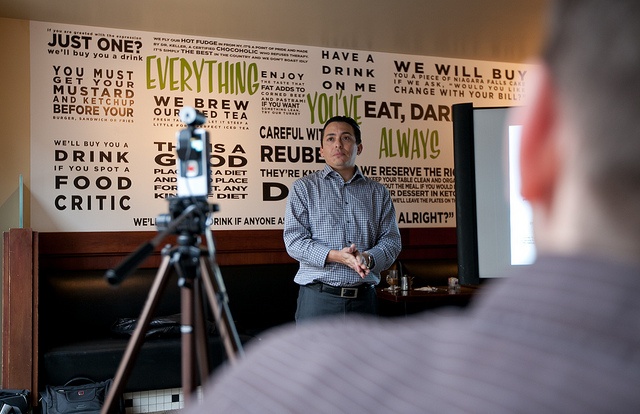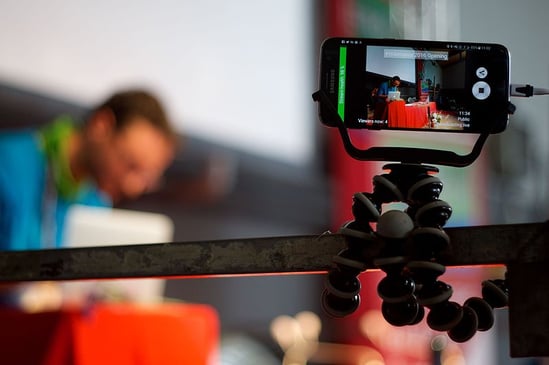Sendible insights How Live Streaming Can Integrate With Your Social Media Strategy at Events
6-minute read
Live streaming is a powerful tool in the social media marketer’s arsenal. With the ability to stream live video to thousands of followers in real time, tools such as Facebook Live and Periscope enable brands to provide customers with a window into their world.
At The International Consumer Electronics Show (CES) in January, there were brands, publishers and influencers, all using live streaming to announce and cover new product releases. Rather than being weighed down by all the necessary post-production which comes with creating videos, the majority of their content was generated live.
As well as announcements, live streaming can be valuable for increasing brand awareness and connecting with clients both old and new. While traditional social media networks such as Twitter and Instagram can provide a snapshot of events, a live stream opens the possibility to create long form content, such as interviews and demonstrations. However, keeping viewers interested remains a steep learning curve for first-time streamers, which is why preparation should begin when creating a social media strategy.
 Image Courtesy of Brian Bolis
Image Courtesy of Brian Bolis
How to prepare for live streaming at an event?
The equipment
The technical part of conducting your own live stream is quite simple. Assuming you have a smartphone or camera which you can connect to a computer, you can host your stream on a variety of networks. Facebook Live, Periscope and YouTube Live are all popular streaming platforms, you just need to be mindful of which social networks your audience is using so that you can build your strategy around them. From there, you can stream to and interact with your audience, which allows you to field questions and respond in real-time.
Most smartphones are equipped with high-resolution cameras which can capture crisp and clear images. While the image quality can hold your content back, they do have the added benefit of having Internet connectivity already built-in, allowing you to move around as you stream. If you are planning on a more formal stream, then digital camcorders are perfect.The only downside here is that you will have to have the camera wired to a laptop to stream the footage online.
The connection
Before the event, make sure you know how reliable the WiFi connection is at the venue. With so many people in such a condensed area, it’s a common problem for Internet connectivity to waver throughout the day. It's smart to check if last year's attendees reported any issues with the connection and always seek other options to keep yours stable.
For example, you can use your mobile data for live streaming at events, but this will eat a lot of your data and drain your battery. Or, you can set up a personal hotspot to connect a digital camera to your laptop and the Internet. Do your research to guarantee that you have a strong and stable signal. It's advisable to use a speed test before streaming at the actual event to check that your chosen network is stable.
To avoid expensive fees on your data usage, you can choose to purchase a SIM only data plan to keep the stream up and running over a couple of days. Remember that live streaming at higher resolutions will eat away any data plan, so ensure you’re covered with enough GBs of data for the duration of the event in advance.
The fine details
While many events are hosted in public places, it’s important to ensure you have all the right permissions to film. Doing so is relatively straightforward – simply get in touch with the event’s organisers who will take you through their guidelines and grant permission if necessary.
Receiving the clearance beforehand is useful not only for keeping the stream running smoothly in the day, but it will also prevent any unlikely copyright infringements which could arise with your content following the event.
Featured below is CNET’s coverage from CES earlier this year. While we’re not expecting you to keep a stream going for eight hours on your first attempt, have a skip through to see all the content they were able to generate in one day. If the live stream is constantly buffering or dropping throughout, this will only result in viewers clicking elsewhere.
Video Source: CNET
Making the most of live streaming at events
After you have the hardware sorted. Then, it’s time to look at how live streaming integrates into your existing strategy. Commonly, a live stream is not just a one-off long form video which is a nice surprise for the audience. Instead, it excels at making your presence known at an event and the content you collect can be quickly re-purposed and distributed across other social media platforms.
All the below can be created at the event and repurposed right after:
- Interviews can be clipped and swiftly transformed into standalone videos. Meanwhile, the quotes can be utilised for articles or blog posts and the snippets can even be used across your social media channels.
- Demonstrations are common at events to attract prospects and start conversations. With live streaming, that footage can later be reused on Facebook, YouTube and more to provide an insight into what your brand is about.
- Behind the scenes footage gives you a chance to share the mission and story of your brand, and the people who make it possible. People love stories and platforms such as Snapchat, Instagram and Twitter are great for sharing short teasers.
Successful live streams often require dedicated planning, but it's usually worth it in the long term. Do remember that your live stream will fail if no one is there to watch it! You need to plan ahead and make sure your followers know that you will be broadcasting at the event.
It's up to you whether you want to share live snippets throughout the day, or choose to stream for two full hours with lots of different activities at the event.
Use this opportunity to network with peers in the industry and interview interesting people or brands. After the event, you can reach out to them before you publish the video and if it's good, they will most likely share it with their audiences as well, giving you and your brand additional exposure.
Then, the quotes can be gathered and swiftly transformed into an article for your website. Finally, highlight snippets are perfect to use on Snapchat and Instagram. This guarantees that one 10-minute interview can be cut down and promoted on a variety of your social media channels, keeping your social media calendar full.
 Image Courtesy of Esino Lario
Image Courtesy of Esino Lario
What does this mean for your social media strategy?
Live streaming has a huge potential for brands, but it's going to require some diligent planning to ensure your live stream is head and shoulders above everyone else at an event.
The quality of live streaming that is so appealing to viewers is that it provides unfiltered access to your brand. All too often, social media content can come across as scripted and reads as a sales pitch rather than focusing on creating a meaningful conversation with the audience.
Studies have already shown that potential clients are more likely to spend money with brands they trust. While traditional social media channels such as Twitter and Facebook have gone some way to bridge that gap; live streaming provides an unscripted, un-edited glance into what the brand is all about. Regardless of whether you are selling building materials, sports equipment or mobile phones – great customer relationships are built upon trust.
If you can demonstrate that you’re reliable and know what you are talking about without the need for expensive work to be done behind the scenes, then you can build a following that extends beyond a 50% off holiday season deal. With live streaming, it’s not just about the hours of content you can create, but the relationships you can further develop with clients through your social media strategy.
Text copied!

